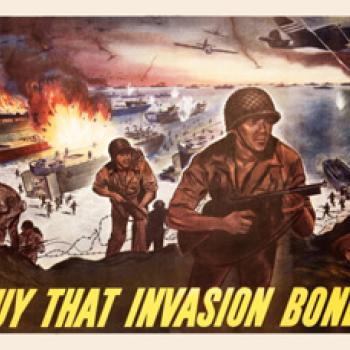Argument, Persuasion, or Propaganda? Analyzing World War II Posters

- Preview |
- Standards |
- Resources & Preparation |
- Instructional Plan |
- Related Resources |
- Comments
Overview
In this lesson plan, students analyze World War II posters, chosen from online collections, to explore how argument, persuasion and propaganda differ. The lesson begins with a full-class exploration of the famous "I WANT YOU FOR U.S. ARMY" poster, wherein students explore the similarities and differences between argument, persuasion, and propaganda and apply one of the genres to the poster. Students then work independently to complete an online analysis of another poster and submit either an analysis worksheet or use their worksheet responses to write a more formal essay.
Featured Resources
- Argument, Persuasion, or Propaganda?: This handout clarifies the goals, techniques, and methods used in the genres of argument, persuasion, and propaganda.
- Analyzing a World War II Poster: This interactive assists students in careful analysis of a World War II poster of their own selection for its use of argument, persuasion, or propaganda.
From Theory to Practice
Visual texts are the focus of this lesson, which combines more traditional document analysis questions with an exploration of World War II posters. The 1975 "Resolution on Promoting Media Literacy" states that explorations of such multimodal messages "enable students to deal constructively with complex new modes of delivering information, new multisensory tactics for persuasion, and new technology-based art forms." The 2003 "Resolution on Composing with Nonprint Media" reminds us that "Today our students are living in a world that is increasingly non-printcentric. New media such as the Internet, MP3 files, and video are transforming the communication experiences of young people outside of school. Young people are composing in nonprint media that can include any combination of visual art, motion (video and film), graphics, text, and sound-all of which are frequently written and read in nonlinear fashion." To support the literacy skills that students must sharpen to navigate these many media, activities such as the poster analysis in this lesson plan provide bridging opportunities between traditional understandings of genre and visual representations.
Further Reading
Common Core Standards
This resource has been aligned to the Common Core State Standards for states in which they have been adopted. If a state does not appear in the drop-down, CCSS alignments are forthcoming.
State Standards
This lesson has been aligned to standards in the following states. If a state does not appear in the drop-down, standard alignments are not currently available for that state.
NCTE/IRA National Standards for the English Language Arts
- 1. Students read a wide range of print and nonprint texts to build an understanding of texts, of themselves, and of the cultures of the United States and the world; to acquire new information; to respond to the needs and demands of society and the workplace; and for personal fulfillment. Among these texts are fiction and nonfiction, classic and contemporary works.
- 3. Students apply a wide range of strategies to comprehend, interpret, evaluate, and appreciate texts. They draw on their prior experience, their interactions with other readers and writers, their knowledge of word meaning and of other texts, their word identification strategies, and their understanding of textual features (e.g., sound-letter correspondence, sentence structure, context, graphics).
- 4. Students adjust their use of spoken, written, and visual language (e.g., conventions, style, vocabulary) to communicate effectively with a variety of audiences and for different purposes.
- 5. Students employ a wide range of strategies as they write and use different writing process elements appropriately to communicate with different audiences for a variety of purposes.
- 11. Students participate as knowledgeable, reflective, creative, and critical members of a variety of literacy communities.
- 12. Students use spoken, written, and visual language to accomplish their own purposes (e.g., for learning, enjoyment, persuasion, and the exchange of information).
Printouts
Websites
Preparation
- Make appropriate copies of Argument, Persuasion, or Propaganda?, Document Analysis for Argument, Persuasion, or Propaganda, and Poster Analysis Rubric.
- Explore the background information on the Uncle Sam recruiting poster, so that you are prepared to share relevant historical details about the poster with students.
- If desired, explore the online poster collections and choose a specific poster or posters for students to analyze. If you choose to limit the options, post the choices on the board or on white paper for students to refer to in Session Two.
- Decide what final product students will submit for this lesson. Students can submit their analysis printout from the Analyzing a World War II Poster interactive, or they can write essays that explain their analysis. If students write essays, the printouts from the interactive serve as prewriting and preparation for the longer, more formal piece.
- Test the Analyzing a Visual Message interactive and the Analyzing a World War II Poster interactive on your computers to familiarize yourself with the tools and ensure that you have the Flash plug-in installed. You can download the plug-in from the technical support page.
Student Objectives
Students will
- discuss the differences between argument, persuasion, and propaganda.
- analyze visual texts individually, in small groups, and as a whole class.
- (optionally) write an analytical essay.
Session One
- Display the Uncle Sam recruiting poster using an overhead projector.
- Ask students to share what they know about the poster, noting their responses on the board or on chart paper.
- If students have not volunteered the information, provide some basic background information.
- Working in small groups, have students use the Analyzing a Visual Message interactive to analyze the Uncle Sam poster.
- Emphasize that students should use complete, clear sentences in their responses. The printout that the interactive creates will not include the questions, so students responses must provide the context. Be sure to connect the requirement for complete sentences to the reason for the requirement (so that students will understand the information on the printout without having to return to the Analyzing a Visual Message interactive.
- As students work, encourage them to look for concrete details in the poster that support their statements.
- Circulate among students as they work, providing support and feedback.
- Once students have completed the questions included in the Analyzing a Visual Message interactive, display the poster again and ask students to share their observations and analyses.
- Emphasize and support responses that will tie to the next session, where students will complete an independent analysis.
- Pass out and go over copies of the Argument, Persuasion, or Propaganda Chart.
- Ask students to apply genre descriptions to the Uncle Sam poster, using the basic details they gathered in their analysis to identify the poster's genre.
Session Two
- Review the Argument, Persuasion, or Propaganda? chart.
- Elicit examples of argument, persuasion, and propaganda from the students, asking them to provide supporting details that confirm the genres of the examples. Provide time for students to explore some of the Websites in the Resources section to explore the three concepts.
- When you feel that the students are comfortable with the similarities and differences of the three genres, explain to the class that they are going to be choosing and analyzing World War II posters for a more detailed analysis.
- Pass out the Document Analysis for Argument, Persuasion, or Propaganda, and go over the questions in the analysis sheet. Draw connections between the questions and what the related answers will reveal about a document's genre.
- Demonstrate the Analyzing a World War II Poster interactive.
- Point out the connections between the questions in the interactive and the questions listed on the Document Analysis for Argument, Persuasion, or Propaganda.
- If students need additional practice with analysis, choose a poster and use the Analyzing a World War II Poster interactive to work through all the analysis questions as a whole class.
- Explain the final format that students will use for their analysis—you can have students submit their analysis printout from the Analyzing a World War II Poster interactive, or they can submit polished essays that explain their analysis.
- Pass out copies of the Poster Analysis Rubric, and explain the expectations for the project.
- If time allows, post the World War II Poster Collection URLs below, and invite students to begin exploring the collections for a poster to analyze.
Session Three
- Review the poster analysis project and the handouts from previous session.
- Answer any questions about the Analyzing a World War II Poster interactive then give students the entire class session to work through their analysis.
- Circulate among students as they work, providing support and feedback.
- Remind students to refer to the Poster Analysis Rubric to check their work before saving or printing their work.
- If you are having students submit their printouts for the final project, collect their work at the end of the session. Otherwise, if you have asked students to write the essay, ask them to use their printout to write the essay for homework. Collect the essays and printouts at the beginning of the next session (or when desired).
- If desired, students might share the posters they have chosen and their conclusions with the whole class or in small groups.
Extensions
The Propaganda Techniques in Literature and Online Political Ads lesson plan offers additional information about propaganda as well as some good Websites on propaganda.
Student Assessment / Reflections
Use the Poster Analysis Rubric to evaluate and give feedback on students’ work. If students have written a more formal paper, you might provide additional guidelines for standard written essays, as typically used in your class.

Add new comment